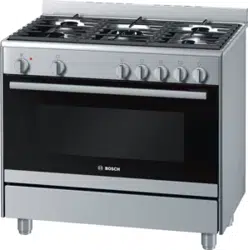Loading ...
Loading ...
Loading ...

Converting the gas type
If the appliance is not already set up for the existing type of gas,
the appliance must be converted. The conversion to a different
type of gas must be carried out by an authorised expert in
accordance with the applicable regulations. The type of gas and
pressure that was preset at the factory are indicated on the
rating plate.
In order to convert to a different type of gas, the nozzles must be
replaced and the low flame and primary air may have to be
adjusted.
Replacing the gas burner nozzles - Fig. 8
1. Disconnect the appliance from the electricity supply.
2. Remove the pan support.
3. Remove the burner cap A and burner cup B from the burner C
(Fig. 8a).
4. Remove the nozzle D and replace it with an appropriate nozzle
for the new type of gas (Fig. 8b).
5. Replace the old gas label with the new gas label.
The new gas label is supplied with the nozzle set.
6. Place the burner cup B onto the burner C.
7. Position the burner cap A exactly on top of the burner cup B
(Fig. 8c).
8. Refit the pan support.
Setting the minimum gas flow - Fig. 9
1. Switch on the gas burner.
2. Turn the control knob for the gas burner towards the small
flame setting.
3. Remove the control knob for the gas burner.
4. Adjust the internal setting screw until a stable flame is burning
correctly.
5. Loosen the setting screw to increase the gas flow or tighten it
to decrease the gas flow.
Note: Make sure that the flame does not go out when the gas
flow is quickly changed between maximum and minimum, and
vice versa.
The setting is correct when the height of the small flame is
approx. 3 to 4 mm.
6. Refit the control knob for the gas burner.
General nozzle table
Nominal operating pressure
The nominal operating pressure of your appliance is:
■ for natural gas - NG (G20) 20 mbar / 2.0 kPa.
■ for liquefied gas - LPG (G30) 30 mbar / 3.0 kPa.
■ for liquefied gas - LPG (G31) 37 mbar / 3.7 kPa.
Your appliance must be operated at these pressure values. All
information on the rating plate refers to these pressure values.
The manufacturer does not accept any liability for operability,
power of the appliance or for other risks if the appliance is
operated at pressure values other than those values specified
for the appliance.
Note: If you are operating the appliance with liquefied gas, use
a gas pressure regulator. The pressure regulator must be
connected and maintained by a licensed technician.
Positioning and levelling
Positioning the appliance
When installing the appliance, make sure that there is enough
space in the final installation location to pull the appliance
forwards for cleaning and maintenance work.
The ground underneath must be hard and firm. The wall
immediately behind the appliance must be made from
non-flammable material, e.g. tiles.
If you need to move the appliance in order to position it, make
sure that the adjustable feet are fully screwed in.
Adjusting the appliance - Fig. 10
Turn the adjustable feet to level the appliance.
Note: Only level the appliance once all other work has been
completed.
Type of gas mbar kPa Nozzle Type of burner Power
W
Power
min. (W)
Max. consumption
Number Bypass G20 G30 G31
Natural gas -
NG
G20
20 2.0 115 (Y) Gap High output burner 3000 800 283 l/h
97 (Z) Gap Standard burner 1800 500 167 l/h
72 (X) Gap Economy burner 1000 400 97 l/h
135 (s) Gap Wok burner 3900 1600 359 l/h
Liquefied gas -
LPG
Butane
Propane
G30/G31
28 -
30/37
2.8 -
3.0/3.7
85 0.45 High output burner 3000 800 218 g/h 214 g/h
65 0.33 Standard burner 1800 500 131 g/h 129 g/h
50 0.30 Economy burner 1000 400 73 g/h 71 g/h
100 0.63 Wok burner 3900 1600 284 g/h 279 g/h
Loading ...
Loading ...
Loading ...
